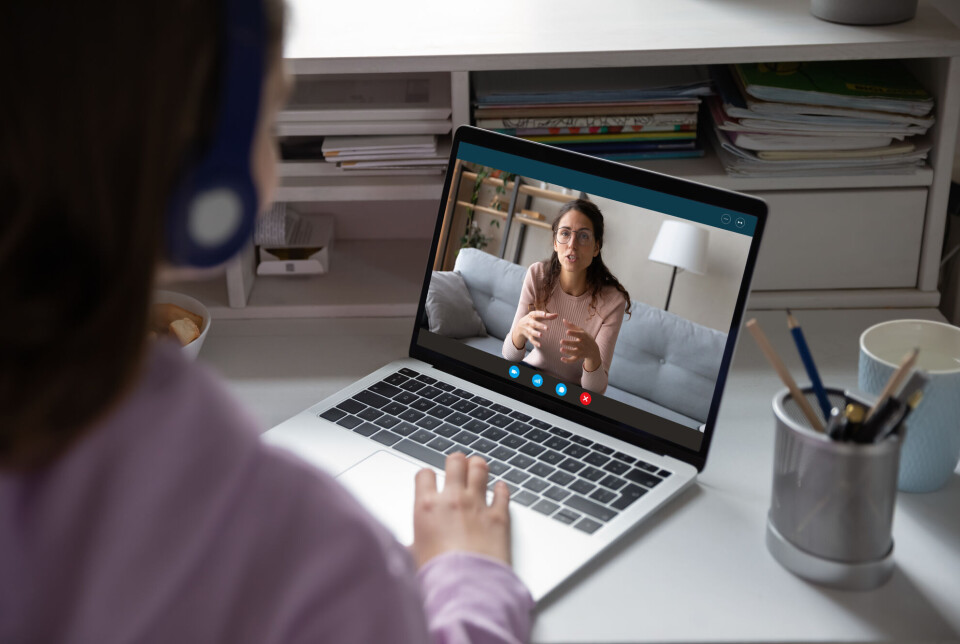THIS ARTICLE/PRESS RELEASE IS PAID FOR AND PRESENTED BY SINTEF - read more

Young people in child protection are critical of digital therapy
Are remote video consultations appropriate for treating children and young people under the care of the child welfare services? Therapists recognise a number of benefits, but most young people are critical of webcam-based therapy.
Research is revealing that while in general, children and young people in the system exhibit a higher incidence of mental health problems and other difficulties than those outside, not all of them are getting the help they need.
Is it possible that video consultations will enable more young people to get this help?
Together with colleagues from the University of South-Eastern Norway and the regional knowledge centres for children and youths (RKBU), researchers at SINTEF have recently compiled a summary of our existing knowledge in this field.
Therapists perceived the treatment as good
The researchers interviewed young people undergoing therapy, and therapists working in the child and adolescent psychiatric services (BUP).
“As part of this project, we reviewed 13 studies, all of which were unanimous in their conclusion that video consultations offer better accessibility to specialist mental health services, not least because they are independent of the geographical distance between the patient and the therapist,” Marian Ådnanes says.
She is the project manager, and also a senior research scientist at SINTEF.
Many of the studies indicated that the quality of treatment was good. However, their conclusions were based exclusively on the opinions of the service provider.

Young people experienced poorer relations with therapists via video
The survey of 221 young people in the welfare system showed that many were critical of psychotherapy consultations using a webcam. 32 of them had previous experience with such consultations.
Of these 32 individuals, 39 per cent said that they felt that the relations they established with the therapist were poorer via webcam than those during a standard face-to-face consultation.
45 per cent said that they found it either a little, or much more difficult to communicate with a therapist via a webcam.
40 per cent responded that treatment via a screen was either only to a very small extent, or not at all, appropriate for them. A similar proportion said that they were only to a small extent, or not at all, satisfied with the therapy they received using a webcam.
A total of 27 in-depth interviews were conducted with young people. Nine of these had previous experience with video consultations.
“In these interviews, the young people spoke of many more shortcomings than benefits. For example, video consultations were perceived as less committing and generally superficial,” says Ådnanes.
Useful during the pandemic
The systemic review also highlighted challenges linked to achieving good mutual therapeutic relations and maintaining concentration during webcam consultations.
Other challenges involved access to equipment and the internet, and personal privacy.
A further critical finding was that therapists failed to monitor development, assess risk, and evaluate the need for support from the child welfare services in the same way as they did during face-to-face meetings.
Therapists responding to the user questionnaire noted that video consultations had enabled them to maintain therapy pathways during the Covid-19 pandemic. They also highlighted the practical benefits to themselves, patients and next of kin of avoiding having to travel long distances for consultations.
The disadvantage was the greater degree of distance in terms of contact with patients during video consultations.
More critical use of video in the future
Many therapists found it difficult to achieve effective contact, flow and a meaningful dialogue. The young people were also consistently less participatory during video consultations.
Many therapists pointed out how important it is to establish good relations before a video consultation takes place.
Therapists working with structured programmes for children with obsessive-compulsive disorder were the most positively inclined to continue with video consultations, estimating that they would conduct therapy in this way for about half of their sessions.
The remaining therapists were less inclined to continue using video, and one stated that it would be highly unlikely.
More research needed
The Norwegian Ministry of Health and Care Services currently operates with a target that, overall, at least 15 per cent of out-patient consultations with the specialist health services should be carried out via telephone or video link.
The innovation strategy that forms part of the Norwegian Health and Hospitals Plan states that if the 15 per cent target for consultations related to anxiety and depression is achieved, this will free up an estimated 7.5 per cent of total consultations, the number of consultations per therapist will increase, and patients will save both time and travel expenses.
According to Marian Ådnanes, more research is needed into the use of video consultations for the treatment of children in the welfare system for mental health issues. Such research will help to clarify, among other things, for whom such consultations are most appropriate, and how the quality of video consultations compares with face-to-face sessions.
More extensive surveys are required, involving many more children and young people in contact with the welfare services.
Children in care are often more sensitive
“Children in the system are often living in difficult and turbulent relationships that may make them particularly sensitive to relational demands,” says Ådnanes. “There is ample support in the literature that good relations between therapist and patient are key to successful psychotherapy. Thus, in the worst case, an expansion of the use of video consultations for children and young people may create new barriers to treatment within the BUP system – in stark contrast to the stated aims of removing such barriers and promoting the continuity of ongoing patient pathways,” she says.
Children should take part in the decision
Kjetil Östling is Director of Services at the Norwegian Directorate for Children, Youth and Family Affairs and is taking the conclusions of the project report very seriously.
“During the pandemic, a great deal of innovation and method testing linked to service provision was carried out in order to monitor the children and young people in the system,” says Östling. “Even if this study is based only on a small sample, the results indicate that the services should not be uncritical in their proposed expansion of the use of video consultations as part of therapeutic programmes,” he says.
“In particular, we want to point out the importance of actively involving the child or young person in deciding how his or her consultation shall be conducted. Therapists should not be basing such choices entirely on their own perceptions which, as this study has indicated, often do not coincide with those of the children,” he says.
Reference:
Ådnanes et al. Bruk av videokonferanse i psykologisk behandling og oppfølging av barn i barnevern (Use of video consultations in the psychological treatment and follow-up of children in child protection), (PDF), SINTEF report, 2022.
See more content from SINTEF:
-
Propellers that rotate in opposite directions can be good news for large ships
-
How Svalbard is becoming a living lab for marine restoration
-
New study: Even brand-new apartments in cities can have poor indoor air quality
-
Fresh hope for patients with chronic inflammatory bowel disease
-
Testing a giant ship: May take five kilometres to stop
-
A robot is helping researchers hunt for the best cancer warriors





































